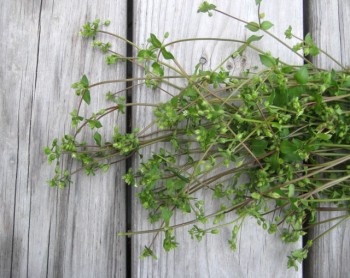
If I don’t get the rest of this New England story out soon I’ll be permanently stopped up in the blog-hole, though perhaps it’s something a large dose of chickweed (Stellaria sp.) could solve.
I already wrote about chickweed in Part I of this series, I know, but I just read an amusing account in Tom Brown’s Field Guide to Wild Edible and Medicinal Plants (1985), wherein he first spends an entire hot and humid day prostrate in a chickweed patch gorging himself on the stuff before suffering “the worse case of diarrhea [he has] had to this day,” followed later by his idea to make an extremely strong chickweed tea for a constipated friend—only to discover that it worked so well his friend was stricken with the shits for days.
When I made chickweed for my parents, I snipped it far down the stems, found it too tough and chewy for my liking, and then wrote about it in Part I of this series. Meanwhile I’ve got Sam Thayer (2006) in the back of my head saying, “The deplorable state of information on edible wild plants can be cleared up over time if those who write on the topic exhibit professionalism and follow a few simple guidelines,” one of which is to “not condemn a plant based on limited experience with it.”
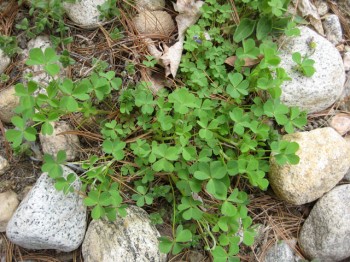
Okay, okay. And then, as if summoned, there’s the answer in Steve Brill’s (1994) book, Identifying and Harvesting Edible and Medicinal Plants in Wild (and Not So Wild Places): “I don’t collect chickweed until I find a thick mat of it,” he writes. “Then, as though I were giving an unruly cat a haircut, I snap off the top few inches.” Ah, I see. Cat haircut. Got it!
I don’t find any stern warnings about chickweed as a cathartic in Brill’s book, though he does mention that it contains saponins. Instead, he lauds the prolific weed for its numerous health benefits. “It’s as safe a food as you can find anywhere, with no harsh or irritating substances,” he writes.
Sorrel & Sheep Sorrel
“I’m sorry I didn’t find any sorrel,” my friend’s daughter repeated back to me, as we sought a mnemonic device to help her commit the name of the yummy, lemony plants to memory.
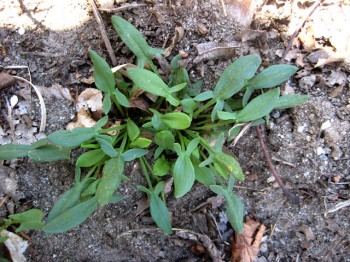
First we tackled wood sorrel (Oxalis sp.), often mistaken for clover but bearing three heart-shaped leaves to clover’s ovals.
Then we delved into sheep sorrel (Rumex acetosella), which is also lemony and characterized by a distinctive leaf-shape—with leaves that are somewhat shovel-shaped, borne singly, and featuring two flared lobes at their bases when mature. The “flowers are green and inconspicuous at first, then flowers/seedheads turn reddish,” Cattail Bob Seebeck (1998) writes of the plant. Sheep sorrel might seem hard to pick out at first, but if you see a reddish-hued hillside later in the season, it might be a good idea to take a closer look, as the hillside might just be covered with the stuff.
The fresh leaves of both sorrels are great in salad, and that’s what my 7-year-old niece and I did with them; we made a tiny salad of wood sorrel, sheep sorrel, chickweed, and carrots—though when it came time to eat it she revealed that raw salad wasn’t really to her liking. I take comfort in the fact that she can lead her mom to the chickweed if there ever is a need for it.
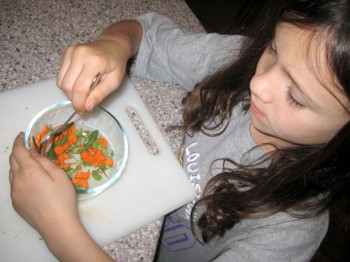
Up here in the Colorado High Country I don’t get enough of any kind of sorrel, even though Cattail Bob reports that sheep sorrel grows up to 11,500 feet in elevation. The only sorrel I find up here above Fairplay, Colorado is mountain sorrel, Oxyria digyna, thought generally not in large enough quantities to merit foraging it.
Note: Like spinach, sorrels contain oxalic acid, and for that reason neither the wild nor cultivated plant should be overindulged upon in one sitting.
Violet Leaves, Thank You Very Much
April was wildflower-recipe-invention month at Hunger and Thirst. My friend Butter posted recipes for Violet Cardamom Soda and Violet Walnut Conserve (where does she get these ideas?!), the first of which involved 3-4 cups of violets, and I couldn’t help but echoing a reader’s sentiment: “That’s a HUGE amount of flowers!!”
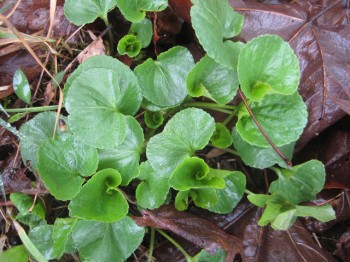
I knew violets were edible but hadn’t given much thought to eating the leaves prior to my trip east, and according to Steve Brill (1994), many people apparently do not: “The common blue violet is a well-loved spring wildflower, but few people know it’s one of the best-tasting, most abundant wild foods of springtime.” He dries quantities of the leaves and flowers to eat year-round, but warns foragers to wait until Viola papilionacea is in flower to make certain of their identification. He also warns not to confuse violets with the also-purple-flowering, toxic larkspur (Delphinium tricorne) or monkshood (Aconitum uncinatum), not to eat the poisonous rhizomes of violets themselves, and not to eat African violets.
In Colorado, Cattail Bob Seebeck warns against confusing the immature leaves of Viola species with heart-leaf arnica, which is also poisonous. “Only use numerous, abundant violets,” Cattail Bob adds. “Some species are rare in the Rockies.”
Back in New Hampshire, however, I found a plentiful yard-full of blue violets and collected several cups of leaves. Fortunately, they kept for several days, as I did not have a chance to try any until returning home with them in my carry-on cooler bag, which incidentally was filled with other edible wild plants as well as meat and fish foraged from my dad’s freezer. We ate our first-ever batch of violet leaves finely chopped in eggs, which is how I try most of my wild edible treats the first time around. Gregg said he liked both the flavor and the texture.
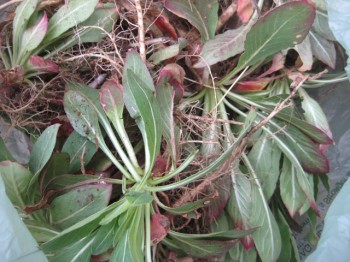
In Edible and Medicinal Plants of the West (1997), Gregory Tilford cautions that too much violet leaf-eating can cause stomach upset due to their saponin content.
Other Spring-Spotted East Coast Wild Edibles
Aside from the plants I’ve written about in detail over the course of these entries, I also found and nibbled on the following plants during my spring stay out east, at least some of which are probably still in season: evening primrose roots (Oenothera sp.), young black birch branches, sassafras leaf stems, and feral chives. I also saw but did not try: curly dock (Rumex crispus), false Solomon’s seal rhizomes (Maianthemum sp.), trout lily bulbs (Erythronium sp.), a couple of purple-flowering mints, plantain (Plantago sp.), milkweed shoots (Asclepias sp.), mallow (Malva sp.), mullein leaves (Verbascum thapsis) for tea, yarrow (Achillea sp.) also for tea, and possibly cow parsnip (Heracleum sp.). I suppose there’s always next time!
Note: I am now officially done with this round of New England foraging adventures. Thanks for reading!

funny post erica…tom brown is definitely an entertaining reader, have you read his surviving in city and suburban areas book? i’ve yet to find sheep sorrel around us either… though i’m always on th’ lookout- and i think cattail bob lives up this way, he obviously knows something we don’t… happy hunting
Thanks Rico… I’ll check it out. We have family members who are quite enamored of Tom Brown. You’ll be the first to know if I find sheep sorrel around here. I’ll be seeing Cattail Bob in a couple weeks; I’ll try to remember to ask. Hope you are fine with that fire & all.